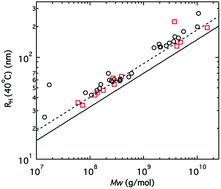Does Flory–Rehner theory quantitatively describe the swelling of thermoresponsive microgels?†
Abstract
The swelling of thermoresponsive microgels is widely modelled through Flory–Rehner theory, which combines Flory–Huggins solution thermodynamics with the affine network model of elasticity. While it has been shown that FR theory closely follows experimental results for a range of systems, the large number of free parameters required to fit size vs. temperature data make a proper evaluation of the theory difficult. In order to test the applicability of FR theory to microgel particles, we analyse viscosity and light scattering data for PNIPAM microgels as a function of temperature, cross-linking degree (f) and molar mass. In the collapsed state, the polymer volume fraction is estimated to be ϕC ≃ 0.44, independent of cross linking degree and molar mass. Fixing ϕC, f and the θ temperature to independent estimates, the FR model appears to describe microgel swelling well, particularly for high cross-linking densities. Estimates for the various fit parameters differ from earlier reports by an order of magnitude. A comparison of the χ parameter obtained from FR theory with values for the linear polymer reveals that the agreement between experiment and theory is somewhat fortuitous. Although the FR model can accurately describe experimental data, the accuracy of the obtained fit parameters is significantly poorer.



 Please wait while we load your content...
Please wait while we load your content...